Craig Garrison, of Garrison Fighting Knives, says on his website that his Garrison Fighting Knife (GFK) is “designed and manufactured exclusively for combat use, i.e., engaging an opponent in an armed, violent encounter.” The website further includes the disclaimer that simply by viewing it the potential customer “agrees to assume all risks and responsibilities for any injury, fatal or otherwise, that may result from handling said weapon.” The GFK and the man behind it make no apologies for what is, explicitly, a weapon. Designed by Craig and manufactured in a variety of suitable machine facilities, the GFK looks like nothing so much as a Klingon knife — something the Predator might carry to the local science fiction convention.
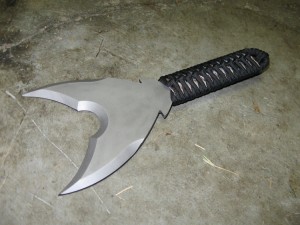
The knife was, according to Craig, inspired by an open pair of scissors as depicted in the Manual del Baratero, a Spanish treatise on knife fighting that you can buy in English tranlsation from Paladin Press. Craig says his GFK can facilitate blocking, trapping, and even throws, thanks to the leverage afforded by the “C” shape of the blade. “Soley intended for the martially minded,” Craig’s GFK is unequivocally (and only) a weapon.
With the knife first out of the box, I have to admit I found the prospect of working with the GFK a little daunting. It’s big and sharp and very, very wide, fitted into a pancake Kydex belt sheath that has to be quite large in order to accommodate what I at first thought of as a sharpened-spatula-of-doom.
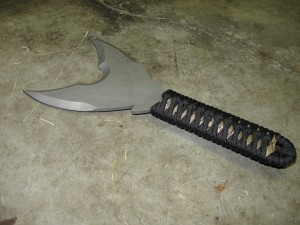
The GFK is about 9.5 inches overall. The distance from tip to tip of the twin points is roughly 4 inches, but the blade swells to about 4.25 inches across at its widest point. The inside of the open “C” shape is sharpened. Roughly three inches of both outer edges are also sharpened.
The knife is not as front-heavy as you might expect; the point of balance falls more or less at the front of the guard-like protrusions forward of the handle. While the GFK has no true guard as such, there’s very little chance your hand could slip from the handle and onto the cutting edges. The paracord-wrapped handle (which is attractive and nicely executed) provides excellent traction (and is large enough for a comfortable grip even in my big mitts). Were your hand to slip forward, you would first encounter the protrusions at the base of the blade. The outside of the blade is unsharpened for more than the first inch of that outer curve.
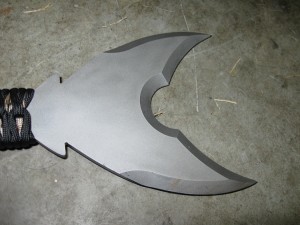
The pancake kydex sheath is split to permit the oddly shaped blade to move in and out. A split sheath like this is the only real option for a knife that is wider at the tip than it is at the base of the blade. Because of this, the knife does rattle a little bit in the sheath; there is no way around that because the sheath must be slightly flexible by design. The knife’s instructions include the caution not to insert or remove the knife in and from its sheath unless the knife is secured on the belt; this is to prevent you from cutting yourself. (I owned, at one time, a dual-blade kerambit of sorts that was like this; it was so wide and curved and sharp in every conceivable plane that you were risking crippling injury just to sheath it.)
The sheath fits securely on my belt and is adjustable for belt width using the Tek-Lok spacer provided. I found the knife rode securely as I went about my business carrying it… but the knife is big and wide, so the sheath is bigger and wider. You have to have a fairly long outer garment to conceal this knife (which may not be legal where you live). It’s as visible sheathed on your belt as a handgun would be.
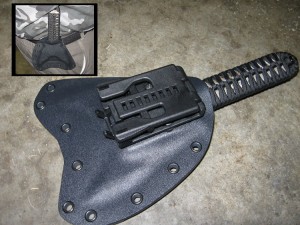
The ATS-34 blade is chisel ground, with a subdued finish. It was nicely sharp out of the box; I used it to carve up, to good effect, a poor, unsuspecting cardboard box. The inner edge would maim an assailant, practically deboning the limb; the dual points would pierce less deeply than would a single, thinner blade, but the leverage afforded by one point would facilitate driving the other point up and into the opponent’s flesh using the lower point as fulcrum. That’s… well, kind of gross, but there you have it.
The knife handles a bit oddly due to its width. A little practice with the trainer is advisable, so that you can become accustomed to this larger blade profile before you reciprocate too closely to your off hand and cut yourself accidentally. Once you’re ready to work with the live blade, you’ll find it wants to spin in your hand (a useful dexterity drill but not something you would do in using it for self-defense). I was most comfortable using the GFK in the reverse grip, but it can be used in the forward grip as readily.
The GFK is essentially a hooking and trapping device, adaptable to Filipino Martial Arts methods with little difficulty. I worked with it in some slightly modified pattern drills and found it an able weapon. It is a specialized tool that must be used with specialized methodology — that is to say, it must be used to take advantage of its function as a trapping, hooking lever. It will stab you, yes, but it’s best used to trap and pass a limb. It will cut you up, yes, but it does this most effectively while grinding away at the flesh of an arm it has just been used to block.
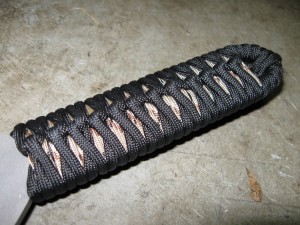
Legally, there are many municipalities in which getting caught with this knife would prompt the authorities to arrest and convict you before burning you at the stake as a witch. Its status as a specialized weapon might be a legal liability after the fact, too, in court — but I believe the justifiability of your actions is the deciding factor, not a Massad-Ayoob-esque hyperanalysis of the tool you used. I would avoid using the GFK anywhere that a double-edged knife is illegal, and anywhere a knife of its size cannot legally be possessed. The rest comes down to how much risk you are willing to assume.
Craig sells the complete line of GFK blades and accessories on his website, including the plexiglass trainer. Knives are available with different handle wraps. I would definitely recommend you purchase the trainer if you intend to own the live blade. You need to practice with the trainer before you carry the GFK.
While decidedly unconventional, I think the GFK — whether one criticizes it as a solution in search of a problem or lauds it as an innovative approach to knife combatives rooted in historical blade culture — does what it is designed to do capably and well. I enjoyed testing and evaluating it, and found Craig gracious and forthcoming in discussing the knife’s development and uses. While it will not be for everyone, the GFK is well executed according to its designer’s vision for this weapon.